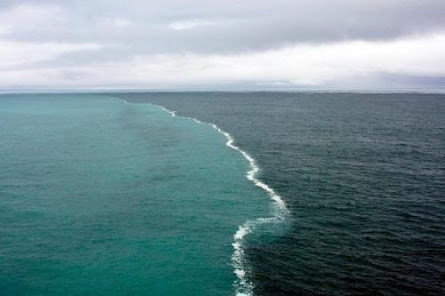Introduction
In the vast expanse of the Gulf of Alaska, where nature reveals its mesmerizing wonders, a remarkable phenomenon unfolds—a breathtaking encounter where two mighty seas converge but refuse to mingle. Nestled between the rugged Alaskan coastline and the sprawling Pacific Ocean lies a captivating boundary known as the sea line, where the distinct waters of the Alaska Current and the California Current meet but do not readily blend.
Picture this
the Alaska Current, a frigid, nutrient-rich stream, surges forth from the north, its icy embrace reaching the Gulf's shores. Carrying the essence of the subarctic realm, this current is born from the icy meltwaters and mighty glaciers that grace the Alaskan landscape. Cold and dense, it brings with it an abundance of life-sustaining nutrients, setting the stage for a bountiful marine ecosystem.
From the opposite direction, the California Current makes its journey northward, tracing the contours of the North American Pacific coastline. Born amidst the sun-drenched realms of the south, it carries the warmth and subtleties of a gentler climate. Its waters, kissed by the sun's radiance, hold a distinct character, rich in vibrant life and teeming with an array of marine inhabitants.
When these two powerful currents clash
When these two powerful currents clash within the Gulf's embrace, a mesmerizing spectacle unfolds—a delicate dance between contrasting elements. Temperature, salinity, and density become the maestros that dictate the performance. The cold, dense waters of the Alaska Current, like an ancient glacier's embrace, sink beneath the warmer, less dense waters of the California Current.
The meeting point, the sea line, becomes a canvas of juxtaposition—a visible frontier where the forces of nature create a striking demarcation. Standing at this ethereal border, one can witness a spectacle of contrasts. On one side, the waters shimmer with a deeper hue, carrying the cooler shades of emerald and cobalt, a testament to the bountiful nutrients that nourish the teeming life beneath. On the other side, a lighter palette emerges, a testament to the warmth and clarity of the California Current.
Ecological significance
But this meeting of the seas is not a mere sight to behold. It is a dynamic tapestry of ecological significance. The sea line serves as a bridge between worlds, a gateway where nutrients from the cold depths of the Alaska Current meet the life-seeking warmth of the California Current. This convergence nurtures a vibrant marine ecosystem, attracting an array of marine species that find solace in the fruitful abundance.
The sea line's position is not steadfast
Yet, the sea line's position is not steadfast, swayed by the whims of seasons and the ebb and flow of oceanic currents. The dance between these currents is ever-changing, influenced by the winds that whisper their secrets and the ocean's unseen tides. With each passing moment, the sea line oscillates, revealing the dynamic nature of this grand convergence.
In the Gulf of Alaska, the sea line stands as a testament to the intricate interplay of nature's forces—an awe-inspiring spectacle where the Alaska Current and the California Current converge but retain their individual essence. It is a place where boundaries blur, where the meeting of worlds reveals the vast beauty and complexity that resides within our planet's restless oceans.

